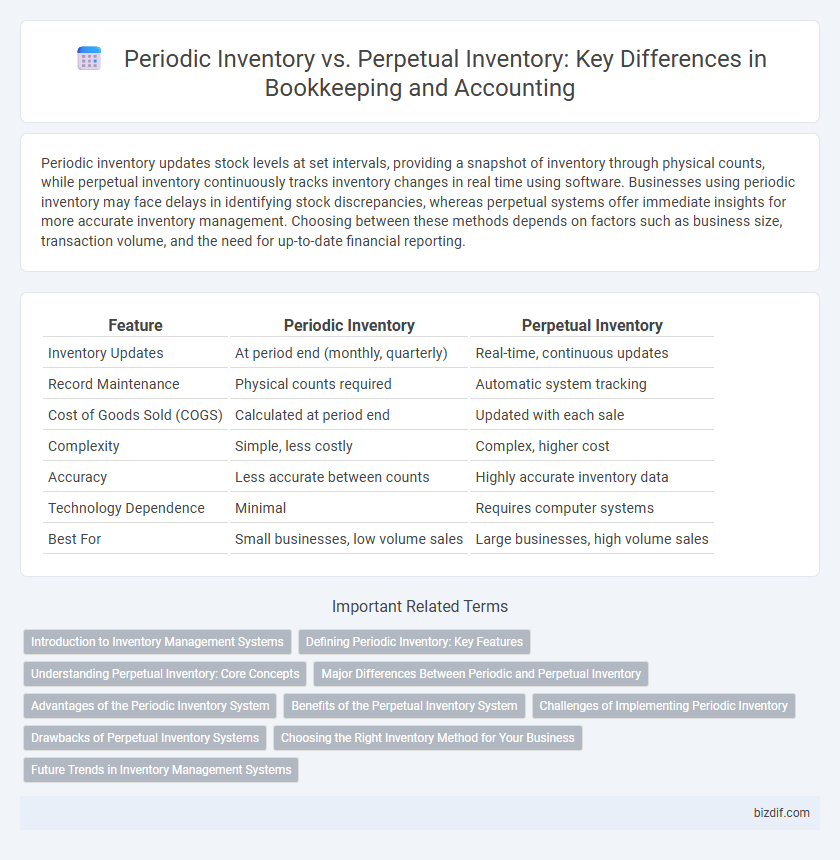Periodic inventory updates stock levels at set intervals, providing a snapshot of inventory through physical counts, while perpetual inventory continuously tracks inventory changes in real time using software. Businesses using periodic inventory may face delays in identifying stock discrepancies, whereas perpetual systems offer immediate insights for more accurate inventory management. Choosing between these methods depends on factors such as business size, transaction volume, and the need for up-to-date financial reporting.
Table of Comparison
| Feature | Periodic Inventory | Perpetual Inventory |
|---|---|---|
| Inventory Updates | At period end (monthly, quarterly) | Real-time, continuous updates |
| Record Maintenance | Physical counts required | Automatic system tracking |
| Cost of Goods Sold (COGS) | Calculated at period end | Updated with each sale |
| Complexity | Simple, less costly | Complex, higher cost |
| Accuracy | Less accurate between counts | Highly accurate inventory data |
| Technology Dependence | Minimal | Requires computer systems |
| Best For | Small businesses, low volume sales | Large businesses, high volume sales |
Introduction to Inventory Management Systems
Periodic inventory systems update stock quantities at specific intervals, relying on physical counts to assess inventory levels, which can result in less timely data. Perpetual inventory systems continuously track inventory transactions in real-time through integrated software, providing accurate and up-to-date stock information. Effective inventory management leverages perpetual systems to enhance accuracy, reduce stockouts, and streamline financial reporting in bookkeeping.
Defining Periodic Inventory: Key Features
Periodic inventory is an accounting method where inventory counts and costs are updated at specific intervals, typically monthly, quarterly, or annually, rather than continuously. Key features include the physical counting of stock to determine ending inventory and the calculation of cost of goods sold (COGS) after inventory is assessed. This system simplifies record-keeping but may lead to less timely inventory data compared to the perpetual inventory method.
Understanding Perpetual Inventory: Core Concepts
Perpetual inventory systems continuously update inventory records in real-time with each purchase, sale, or return, providing accurate stock levels at any moment. This method relies on integrated technology such as barcode scanners and inventory management software to track inventory movement immediately. Businesses benefit from reduced stockouts and improved order accuracy by maintaining an up-to-date, detailed ledger of inventory activities.
Major Differences Between Periodic and Perpetual Inventory
Periodic inventory updates stock levels and cost of goods sold at specific intervals, often monthly or quarterly, relying on physical counts to determine inventory. Perpetual inventory continuously tracks inventory transactions in real-time, providing updated stock quantities and cost information after each sale or purchase. The major difference lies in timing and accuracy, with perpetual inventory offering more precise and timely data compared to the periodic system's reliance on periodic physical verification.
Advantages of the Periodic Inventory System
The Periodic Inventory System offers simplicity and cost-effectiveness by requiring fewer resources for continuous tracking, making it ideal for small businesses with low inventory turnover. It allows for easy stocktaking at specific intervals, providing clear snapshots of inventory levels without the need for complex software or real-time data entry. This system also reduces administrative burden by consolidating inventory adjustments into periodic counts, streamlining financial reporting and inventory management.
Benefits of the Perpetual Inventory System
The perpetual inventory system provides real-time tracking of inventory levels, enabling more accurate financial reporting and reducing the risk of stockouts or overstocking. It enhances operational efficiency by automating inventory updates with each sale or purchase, improving inventory management accuracy and decision-making. This system also supports better loss prevention through continuous monitoring, which helps identify discrepancies from theft, damage, or errors promptly.
Challenges of Implementing Periodic Inventory
Implementing periodic inventory presents challenges such as the risk of inventory inaccuracies due to infrequent stock counts, leading to potential stockouts or overstocking. Businesses may face disruptions during physical counts, causing operational downtime and labor costs. Furthermore, the lack of real-time inventory data complicates demand forecasting and timely decision-making.
Drawbacks of Perpetual Inventory Systems
Perpetual inventory systems often face challenges such as higher implementation costs and increased complexity in maintaining real-time data accuracy. These systems require continuous updating and sophisticated software, which can be prone to errors if data entry is incorrect or if there are system malfunctions. Inventory discrepancies may occur due to theft, damage, or administrative mistakes, reducing the reliability of perpetual inventory records compared to periodic counts.
Choosing the Right Inventory Method for Your Business
Selecting the right inventory method depends on your business size, transaction volume, and accuracy needs. Periodic inventory suits smaller businesses with lower transaction frequency, offering simplicity and reduced bookkeeping effort. Perpetual inventory provides real-time tracking ideal for larger businesses requiring precise stock management and timely financial insights.
Future Trends in Inventory Management Systems
Future trends in inventory management systems emphasize the integration of AI and IoT technologies to enhance accuracy and real-time tracking, shifting the industry focus from traditional periodic inventory methods towards more dynamic perpetual inventory systems. Advanced analytics and machine learning algorithms enable predictive insights, optimizing stock levels and reducing carrying costs more effectively than conventional periodic counts. Cloud-based platforms and automated data capture streamline inventory processes, ensuring continuous updates and minimizing human error in perpetual inventory management.
Periodic Inventory vs Perpetual Inventory Infographic

 bizdif.com
bizdif.com